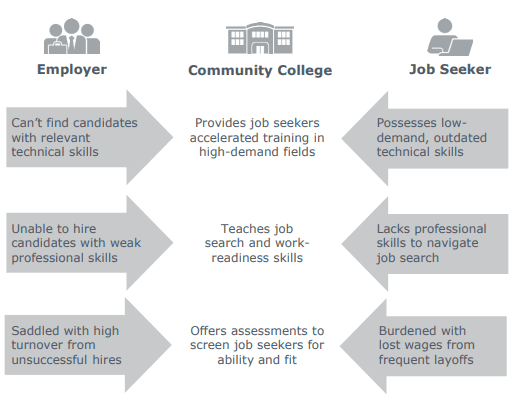Read our study to discover 11 best practices to help you recapture adult learner enrollments.
Executive Summary: Beneath the enrollment headlines
Since the height of the Great Recession, community colleges nationwide have seen substantial enrollment declines among students age 25 and older. Although adult learners commonly leave college during economic recoveries, this decline is more than just a cyclical trend—it also reflects growing enrollment competition from for-profit and four-year universities.
Adult learners may value the convenience of for-profit institutions and the brand of four-year universities, but career relevance ultimately guides their college choice. Within this context, community colleges’ greatest assets are their employer partnerships. This study examines how colleges can leverage these partnerships to recruit adult learners who seek to advance or reboot their careers.
This resource is part of the Create a Community College Pipeline to Place Students in Right-Fit Careers Roadmap. Access the Roadmap for stepwise guidance with additional tools and research.
What deters adult learners from enrolling?
5%
Many adult learners do not return to college despite the professional advantages that further education can confer. Some of these potential students face financial, administrative, and psychological barriers to enrollment. Others find that available program options do not align with their career goals—or duplicate content they’ve already mastered on the job. Even unemployed and underemployed workers may hesitate to invest in training because they are uncertain whether it will benefit their job search.
To help you overcome these challenges, we’ve outlined 11 best practices below.
Remove barriers to enrollment
Financial costs, college reentry anxiety, and complex admissions processes often prevent adult learners from enrolling in college. This section examines how to facilitate enrollment for working adults, in part by promoting the use of tuition reimbursement benefits.

College Reentry Anxiety
Adults with limited college experience fear entering campus or returning to the classroom

Complex Enrollment Process
Professional obligations prevent adults from visiting campus during workday to complete various steps required for admission

Finances
Prospective students choose not to enroll because they cannot afford up-front tuition payment
Practice 1: Deferred tuition reimbursement billing
To eliminate the up-front costs of using tuition reimbursement, Des Moines Area Community College (DMACC) allows students to defer payment until after the term ends. A qualifying student must submit a promissory note to the college before classes start. Her employer must sign the note to indicate that the company’s tuition reimbursement policy covers the applicable courses, and the student must sign the note to confirm that she assumes full responsibility for payment.
Practice 2: Noncredit-to-credit course discount

Many adult learners who hesitate to enroll in credit-bearing courses find noncredit training more accessible because of the less formal learning environment. In 2010, Snead State Community College introduced an incentive that encourages students to use noncredit training as a bridge to credit-bearing programs.
Students who complete Snead State’s noncredit work readiness training qualify for one free three-credit course in a program of their choice. This course serves as a free trial; it allows students to evaluate their readiness for college-level coursework at no financial risk. After students gain confidence in their abilities, they can continue to take courses toward a certificate or degree at the standard tuition rate.
Practice 3: Employer-based enrollment advisor
15%
To facilitate enrollment for working adults, Gateway Community and Technical College places on-site advisors with key employer partners. Much like college staff who visit employers for education fairs, the on-site advisor helps workers navigate their tuition benefits.
However, unlike these other college representatives, the on-site advisor can also help workers complete much of the enrollment process. For example, workers can visit the advisor to complete their online applications, receive assistance with financial aid forms and transcript requests, and register for courses.
Align program options with career goals
81% of adult undergraduates primarily enroll in college to start, change, or advance in their careers.
Aslanian Market Research survey
Between work and family commitments, most adult learners only have time for education if it helps them advance in their careers. This section explores how to design and market programs that align with working adults’ professional goals—and fit into their busy lives.
Practice 4: Stackable certificate career roadmap
To demonstrate the value of additional credentials, college administrators can work with key employer partners to map career ladders available at the employer to stackable credentials available at the college.
For example, a college may develop a road map with an IT firm that indicates that their tech support certificate prepares graduates to work as entry-level help desk coordinators, while their associate’s degree prepares graduates for promotion to network technician. Such road maps provide guidance on the most appropriate time in a worker’s career to pursue a given credential. Moreover, road maps help workers understand how an additional credential can lead to advancement, which encourages them to return to the college for further training.
Practice 5: Centralized prior learning portal
200
In February 2015, the Pennsylvania Commission for Community Colleges launched College Credit Fast Track, a statewide portal to standardize and streamline the prior learning assessment process for students. This portal serves as a centralized resource on all assessment options, including portfolios, standardized exams, and military transcripts. In addition, it provides a platform for students to build and share portfolios for review.
Practice 6: Corporate training credit crosswalk
Students who complete formal corporate training programs can benefit from crosswalks that directly map their training to college credits. Ivy Tech Community College maintains such a crosswalk with McDonald’s. In 2014, Ivy Tech’s faculty curriculum committee mapped the learning outcomes of McDonald’s Hamburger University trainings to those of Ivy Tech’s courses. The resulting crosswalk allows Hamburger University trainees to earn up to 21 credits toward Ivy Tech’s online degrees in business administration or general studies.

College
Recruits and retains working adults in programs aligned with career goals

Employer
Gains accelerated options to upskill current workers for promotion

Student
Completes only those courses relevant and necessary to advance their careers
Facilitate the hiring process
Many employers are struggling to fill open positions, yet millions of unemployed workers still have difficulty finding work. This section explores how community colleges can persuade job seekers to retrain, thus bridging the hiring gap while increasing enrollments.
Accelerated Training Removes Roadblocks for Employers and Job Seekers Alike

Practice 7: Community-based career boot camps
40%
At the height of the Great Recession, Lorain County Community College (LCCC) demonstrated the value of retraining through career decision boot camps. These three-hour sessions helped dislocated workers select a new career path and identify relevant retraining options. Across the first three years that LCCC hosted career decision boot camps, over 2,000 unemployed and underemployed workers attended. During this same time frame, 458 boot camp attendees went on to enroll in the college. For many of these incoming students, the boot camp demonstrated the value of returning to college for further training.
Practice 8: Class-wide speed interviewing
After workers complete retraining, they may still face a daunting job search. To ease this process, Bossier Parish Community College (BPCC) hosts a speed interviewing event for students in their advanced manufacturing and mechatronics certificate. During the week of program graduation, seven to nine local manufacturing employers visit campus for one day to review résumés and conduct 15-minute interviews with every student.
Practice 9: Training-based job screen
1,040
In 2012, Southwest Tennessee Community College created an alternative hiring process for entry-level manufacturing jobs that does not rely on résumés. Employers that participate in the college’s Industrial Readiness Training program (IRT) customize a five-week noncredit training program to reflect the technical skills and soft skills they seek in new workers. These employers receive access to student performance records, including their scores on career readiness and mechanical aptitude assessments. Employers may also observe students in class to evaluate their professional skills. At the end of the training, employers select students to interview based on their performance.
Practice 10: Guaranteed employment offer

While successful workforce training programs often lead to job interviews, an organization called WorkAmerica seeks to go one step further. This startup aims to offer graduates not just an interview but a guaranteed placement.
WorkAmerica partners with community colleges to find employers willing to hire any student who graduates from select training programs in high-demand fields such as welding and commercial truck driving. Because these employers pay WorkAmerica for their recruiting services, partnership is free to the college.
Practice 11: Employer-sponsored degree completion
100%
In 2010, Austin Community College (ACC) and Samsung Austin Semiconductor launched a partnership that fulfills the employer’s immediate hiring needs while promoting college completion. Under the Technician Apprenticeship Program, ACC helps Samsung recruit current electronics students to work part-time at their local facility. To qualify for these part-time jobs, students must have a 3.0 GPA and at least 28 credits toward a relevant associate’s degree.
In exchange for access to these high-performing students, Samsung sponsors their continued enrollment at ACC while employed. These part-time workers must pursue at least six credits per term, and Samsung pays for any tuition not covered by financial aid.
Supporting tools
This study examines how colleges can recruit adult learners by removing barriers to enrollment, aligning program options with career goals, and facilitating the hiring process for graduates.
Next, grow employer partnerships
Discover nine disciplines and five tools to match academic units with employers, invest in those relationships, and deliver on goals.
This resource requires EAB partnership access to view.
Access the research report
Learn how you can get access to this resource as well as hands-on support from our experts through Strategic Advisory Services for Community Colleges.
Learn More